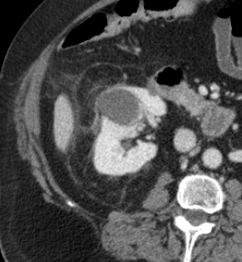Answer

There is a low density cystic structure in the anterior aspect of the right kidney At the level where it bulges beyond the confines of the kidney there are soft tissue changes in the perinephric fat and extending to the preperitoneal fat. A small enhancing medial rim may be part of the abscess or part of the kidney. These findings are not absolutely pathognomonic but in the appropriate clinical setting the diagnosis of abscess would be most likely. Next step would be percutaneous drainage under imaging guidance
Ashley Davidoff MD TheCommonVein.net
A renal abscess is a collection of pus within the kidney tissue. It is typically caused by a bacterial infection that spreads to the kidneys. Renal abscesses are relatively uncommon but can be a serious condition if left untreated.
Characteristics of renal abscess on a CT (computed tomography) scan may include:
- Fluid Collection: A renal abscess appears as a well-defined fluid collection within the kidney. This collection is often surrounded by a capsule or wall of tissue.
- Low Density: The pus inside the abscess has lower density than the surrounding healthy kidney tissue, resulting in a lower attenuation on CT scans. This is typically seen as a hypodense area.
- Enhancement Patterns: Depending on the stage of the abscess and the presence of inflammation, the enhancing patterns on contrast-enhanced CT scans may vary. Early in the process, there might be peripheral enhancement due to inflammation, while later stages may show less enhancement.
- Gas Formation: In some cases, gas may be present within the abscess. Gas is a concerning sign as it suggests a more advanced and potentially severe infection.
- Surrounding Inflammation: The abscess may be associated with inflammation in the surrounding tissues, which can be visualized on the CT scan.
- Demarcation: The abscess often has a well-defined border, helping to distinguish it from the normal kidney tissue.
